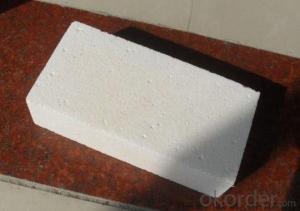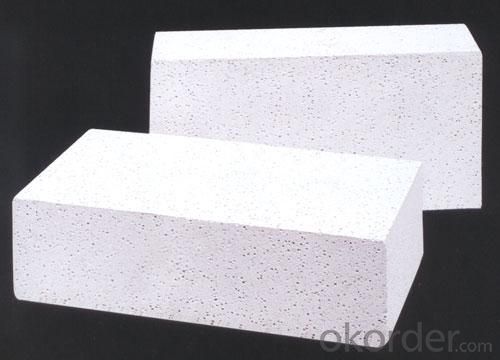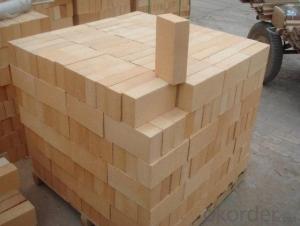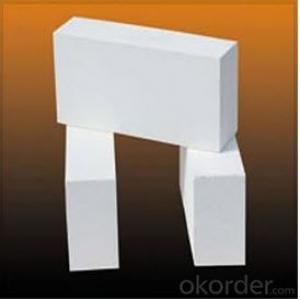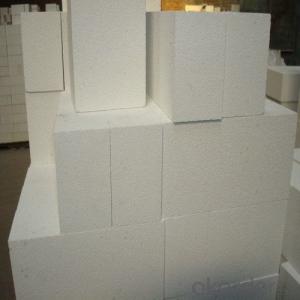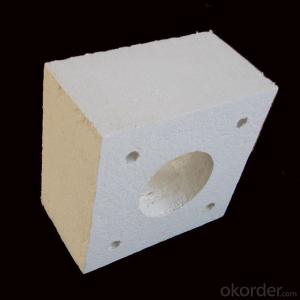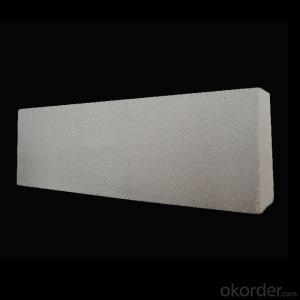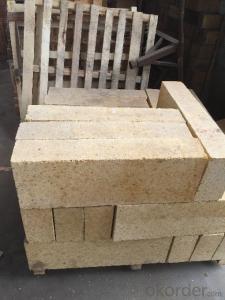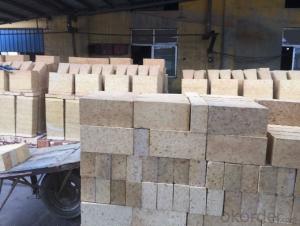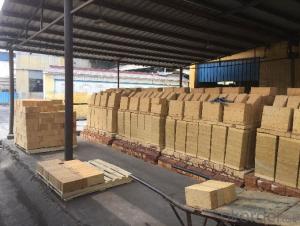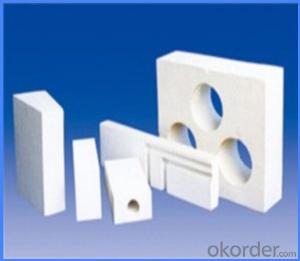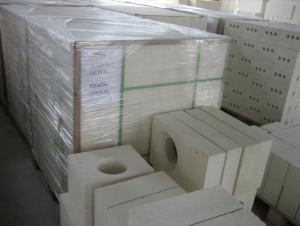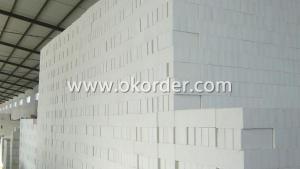Insulating Fire Brick 65% Al2O3 Min High Alumina
- Loading Port:
- Shanghai
- Payment Terms:
- TT OR LC
- Min Order Qty:
- 500 m.t.
- Supply Capability:
- 1000 m.t./month
OKorder Service Pledge
OKorder Financial Service
You Might Also Like
Specifications
1.65% Al2O3 min;
2. Refractoriness: 1790C min;
3.For steelmaking furnaces;
4.ISO 9001 Certificate;
5.Custom shape.
High alumina insulating fire brick is a kind of insulation material adopting organic matter as ignition loss substance in order to increase the porosity of refractory, which has such advantages as high porosity, small volume density, good insulation effect, high mechanical intensity, small thermal conductivity and long service life. For various industrial kilns & furnaces, it is a kind of essential refractory for energy saving and temperature preservation.
This series of High Alumina Insulating Fire Brick are made of selected high alumina bauxite, kaolin caly, hollow microsphere as the mian material.By shaping at high pressure and sintering at high temperature.
| Items | Mark | ||||||
Hihg Alumina brick | Clay brick | Phosphoric acid dipping clay brick | |||||
| GL-65 | GL- 55 | GL- 48 | ZGN-42 | ZGN-42 | |||
| Chemical Compositions ( %) ≥ | Al2O3 | 65 | 55 | 48 | 42 | 42 | |
| Fe2O3 | 2.0 | 2.0 | 2.0 | 1.6 | 1.7 | ||
| P2O5 | - | - | - | - | - | 7 | |
| Refractoriness ℃ | 1790 | 1770 | 1750 | 1750 | 1750 | - | |
| Apparent Porosity (%)≤ | 19 | 19 | 18 | 15 | 16 | 14 | |
| Alkali resistance (strength degradation)%≤ | - | - | - | - | - | 15 | |
| 0.2MPaRefractoriness under load,℃≥ | 1500 | 1480 | 1450 | 1450 | 1430 | 1450 | |
| CCS (Mpa)≥ | 58.8 | 49 | 49 | 58.8 | 49 | 60 | |
| Dead burnt linear change(%)≤ | 1450℃×2h | 0/-0.2 | 0/-0.2 | 0/-0.3 | 0/-0.2 | ||
| 1500℃×2h | 0/-0.2 | ||||||
Starting from the raw material into factory, Every production process of high alumina insulating fire bricks should through strict quality control, both the raw materials and finished products should be inspected time after time, to esure that each product to satisfy our customers, because of advanced automatic batching system and 2500 tons automatic hydraulic machine in the world were introduced, then a new line of the ladle fire bricks and other styling refractory products with a superior quality was put into production.
- Q: Can insulating fire bricks be used for insulation in solar thermal systems?
- Yes, insulating fire bricks can be used for insulation in solar thermal systems. These bricks have high insulating properties and can withstand high temperatures, making them suitable for use in solar thermal systems where insulation is crucial to maximize heat retention and efficiency.
- Q: Can insulating fire bricks be used in the construction of drying ovens?
- Yes, insulating fire bricks can be used in the construction of drying ovens. Insulating fire bricks are designed to have low thermal conductivity, which means they can effectively retain heat and prevent heat loss. This makes them an ideal material for constructing drying ovens, as they can help maintain a constant and controlled temperature within the oven. Additionally, insulating fire bricks are resistant to high temperatures, making them suitable for use in drying ovens where elevated temperatures are required.
- Q: Can insulating fire bricks be used in the construction of pottery extruders?
- Yes, insulating fire bricks can be used in the construction of pottery extruders. Insulating fire bricks are known for their high heat resistance and insulation properties, making them ideal for applications involving high temperatures, such as pottery kilns and extruders. These bricks can withstand the intense heat generated during the pottery extrusion process, ensuring the longevity and durability of the extruder. Additionally, their insulation properties help to maintain a consistent temperature within the extruder, which is crucial for achieving precise and consistent results in pottery production. Therefore, using insulating fire bricks in the construction of pottery extruders is a reliable and effective choice.
- Q: How do insulating fire bricks affect the overall carbon footprint of a structure?
- Insulating fire bricks can significantly reduce the carbon footprint of a structure. These bricks have higher thermal insulation properties compared to traditional bricks, which means they can better retain heat and reduce the need for excessive heating or cooling. By improving energy efficiency and reducing the consumption of fossil fuels, insulating fire bricks help to lower the carbon emissions associated with the structure's operation. Additionally, their longer lifespan and recyclability contribute to further environmental benefits by reducing waste generation and the need for frequent replacements, ultimately minimizing the overall carbon footprint of the structure.
- Q: Can insulating fire bricks be used in refractory linings for blast furnaces?
- Yes, insulating fire bricks can be used in refractory linings for blast furnaces. Insulating fire bricks are designed to have low thermal conductivity, which means they can effectively reduce heat loss from the furnace. This property is particularly important in blast furnaces, where maintaining high temperatures is essential for efficient operation. Insulating fire bricks are made from lightweight refractory materials such as alumina or silica, which have high insulating properties. These bricks not only provide thermal insulation but also have good resistance to thermal shock, making them suitable for the extreme conditions found in blast furnaces. In addition to insulation, insulating fire bricks also offer other advantages for blast furnace linings. They are lightweight and easy to install, which reduces the labor and time required for construction. Furthermore, their low thermal conductivity can help to minimize the formation of hot spots and uneven temperature distribution within the furnace, which can lead to premature wear and failure of the refractory lining. However, it's important to note that insulating fire bricks alone may not be sufficient for all parts of the blast furnace lining. Certain areas, such as the hearth and tuyere zones, may require high-density refractory bricks that can withstand the intense heat and mechanical stress. In these cases, a combination of insulating fire bricks and other refractory materials may be used to achieve the desired performance and longevity. Overall, insulating fire bricks can be a valuable component in refractory linings for blast furnaces, helping to improve energy efficiency, reduce heat loss, and prolong the lifespan of the lining.
- Q: Can insulating fire bricks be used in the construction of foundry molds?
- Yes, insulating fire bricks can be used in the construction of foundry molds. Insulating fire bricks are made from lightweight materials such as clay, alumina, and silica, and are designed to have low thermal conductivity. This makes them ideal for applications that require high temperature resistance and insulation, such as foundry molds. Foundry molds are used to shape and hold molten metal during casting processes. Since molten metal is typically poured at extremely high temperatures, it is important to use materials that can withstand the heat without melting or deforming. Insulating fire bricks have a high melting point and excellent thermal stability, which makes them suitable for use in foundry molds. In addition to their high temperature resistance, insulating fire bricks also provide good insulation properties. This is important in foundry molds as it helps to control the cooling rate of the molten metal, preventing thermal shock and ensuring proper solidification. The insulation properties of insulating fire bricks can also help to reduce energy consumption and improve the overall efficiency of the foundry process. Overall, insulating fire bricks are a durable and efficient choice for constructing foundry molds. They offer high temperature resistance, excellent thermal stability, and good insulation properties, making them a reliable option for use in the demanding conditions of foundry operations.
- Q: Are insulating fire bricks suitable for use in carbon black furnaces?
- Yes, insulating fire bricks are suitable for use in carbon black furnaces. These bricks are known for their high insulation properties, which help in maintaining high temperatures inside the furnace while preventing heat loss. Additionally, insulating fire bricks are designed to withstand extreme temperatures and chemical reactions, making them a suitable choice for carbon black furnaces that operate under high heat and harsh conditions.
- Q: Can insulating fire bricks be used for insulation in steel mills?
- Insulation in steel mills is possible with the use of insulating fire bricks. These bricks are crafted from lightweight refractory materials that possess exceptional insulating properties and can endure high temperatures. Their purpose is to limit heat transfer and maintain the desired temperature within the furnace or kiln. In the steel mills, these bricks are applicable for insulating the walls, floors, and roofs of the furnaces, ladles, and other equipment. This insulation aids in minimizing heat loss, enhancing energy efficiency, and ensuring consistent and controlled heating processes. Moreover, insulating fire bricks offer thermal stability and safeguard the steel mill equipment against excessive heat, thereby contributing to extended equipment lifespan and reduced maintenance expenses.
- Q: Are insulating fire bricks suitable for use in thermal power plants?
- Yes, insulating fire bricks are suitable for use in thermal power plants. Insulating fire bricks are designed to have low thermal conductivity, which means they can effectively retain heat and prevent heat loss. In thermal power plants, where high temperatures are generated, insulating fire bricks can be used as linings for furnaces, boilers, and other equipment to provide thermal insulation and increase energy efficiency. Additionally, these bricks are resistant to high temperatures and can withstand thermal shocks, making them ideal for use in environments with extreme heat. By using insulating fire bricks in thermal power plants, operators can reduce heat loss, increase the overall efficiency of the plant, and improve the durability and lifespan of the equipment.
- Q: Can insulating fire bricks be used for fireplace lining?
- Yes, insulating fire bricks can be used for fireplace lining. These bricks are designed to withstand high temperatures and provide excellent insulation, making them suitable for lining the inside of a fireplace. They help to retain heat and improve the efficiency of the fireplace while protecting the surrounding structure from excessive heat.
Send your message to us
Insulating Fire Brick 65% Al2O3 Min High Alumina
- Loading Port:
- Shanghai
- Payment Terms:
- TT OR LC
- Min Order Qty:
- 500 m.t.
- Supply Capability:
- 1000 m.t./month
OKorder Service Pledge
OKorder Financial Service
Similar products
Hot products
Hot Searches
Related keywords
